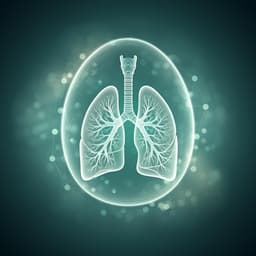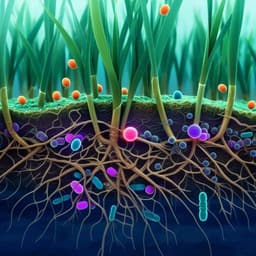
Physics
A swift technique to hydrophobize graphene and increase its mechanical stability and charge carrier density
L. Madauß, E. Pollmann, et al.
Discover an innovative technique for transferring single-layer graphene from copper substrates without defects, developed by researchers Lukas Madauß and colleagues. Their method enhances graphene stability and purity, presenting a breakthrough in wet-chemical transfer processes in water.
~3 min • Beginner • English
Introduction
The study addresses a key bottleneck in applications of CVD-grown single-layer graphene on copper (Cu): transferring the graphene to target substrates without damaging it or leaving residues. Conventional polymer-supported transfers (e.g., PMMA, PVA, paraffin) stabilize the film but leave residues and often require harsh post-treatments, degrading graphene’s properties. The authors propose a pre-treatment of graphene-on-copper (Gr/Cu) by mechanically flattening with an ethylene–vinyl acetate copolymer (EVAC) foil using a standard vacuum bag sealer. This treatment stabilizes graphene via attachment of functional carbon groups, enabling a polymer-free, all-water wet transfer. The work tests the hypothesis that graphene crumbling in water is driven primarily by polar interactions with water rather than differences in total surface energy, and demonstrates that suppressing polar interactions increases mechanical integrity during transfer, yielding highly crystalline, clean, nearly fully covered graphene films.
Literature Review
The paper reviews CVD graphene transfer methods that rely on polymer supports (PMMA, PVA, paraffin) and notes persistent challenges with polymer residues, non-uniform doping, and the need for additional chemicals or heating to clean, which can still leave contamination (citing works on transfer techniques and post-cleaning). It references alternative polymer-free or specialized transfers (electrochemical delamination, face-to-face transfer, paraffin-enabled, PVA-assisted, and other polymer-free approaches) and highlights ongoing issues with universality, cleanliness, and substrate restrictions. It also cites background on graphene growth on Cu and applications (membranes, sensors), and prior understanding attributing transfer failure to surface energy differences with water.
Methodology
Pre-treatment (flattening) and transfer:
- Graphene on Cu (single-layer Gr/Cu from Graphenea) is placed on a solid, smooth plate and covered with an EVAC foil (ethylene–vinyl acetate copolymer).
- The assembly is inserted into a standard vacuum bag and sealed using a commercially available vacuum bag sealing machine, which presses the EVAC foil against the graphene surface. The foil remains in contact for at least 24 hours.
- The Cu is etched in an aqueous ammonium persulfate (APS) solution: 7 g APS dissolved in 200 mL deionized water.
- The etching solution is gradually diluted with DI water; the graphene is then scooped onto the target substrate from a pure H₂O bath without any polymer support layer.
Characterizations:
- Raman spectroscopy: Renishaw InVia, 532 nm excitation, laser power <100 μW, mapping to assess defect density (AD/AG) and doping via G-mode position (and I2D/IG in Supplementary).
- Atomic Force Microscopy (AFM): Bruker Dimension FastScan, PeakForce Tapping mode, to assess surface cleanliness and residues.
- Scanning Electron Microscopy (SEM): for morphology of Gr/Cu before transfer (regular vs flattened) and surface cleanliness (particle density) at micrometer scale.
- X-ray Photoelectron Spectroscopy (XPS): VersaProbe II (Ulvac-Phi), monochromatic Al Kα source, 45° incidence, to quantify sp2/sp3 and C–O components, and estimate graphene vs adventitious carbon contributions as a function of flattening time and contact materials (EVAC, PC, PET, Al).
- Time-of-Flight Secondary Ion Mass Spectrometry (ToF-SIMS): IONTOF TOF-SIMS 5, Bi³⁺ primary ions at 30 kV, electron flood gun for charge compensation. Negative ion spectra analyzed; focus on m/z 59 attributed to acetate fragments.
- Contact-angle measurements: OCA 15EC (DataPhysics). A 2 μL droplet is dispensed; sessile drop formed by touching the substrate and retracting the needle. Measurements under ambient conditions. Test liquids include water, diiodomethane, and glycerol (per Supplementary). Surface energy components (polar σp and dispersive σd) are derived via the Owens–Wendt method from measured contact angles.
Parameter variations:
- Flattening time varied from 0 s to 2 days to study transfer success, contact angle, XPS composition changes.
- Different contact materials tested for flattening (EVAC, PC, PET, Al) to assess the role of adsorbate chemistry on transfer success and surface energy components.
Key Findings
- Polymer-free all-water transfer enabled by EVAC flattening: Pre-flattened graphene can be scooped from pure H₂O without a support layer, maintaining wafer shape and achieving near-100% coverage; non-flattened graphene crumbles and rips.
- Defect density markedly reduced: Raman mapping shows average AD/AG ≈ 0.04 for flattened graphene vs ≈ 0.2 for PMMA-assisted transfer (no post-treatments applied).
- High p-type doping from EVAC treatment: Raman G-mode shift indicates p-doping with estimated carrier concentrations (via Bruna et al.) of ~5 × 10^12 cm⁻2 (PMMA-transferred) and ~1.5 × 10^13 cm⁻2 (flattened graphene).
- Cleanliness: AFM reveals numerous nm-scale residues on PMMA-transferred graphene, whereas flattened graphene surfaces are largely free of contaminants over large areas; bright AFM features on flattened samples are attributed to overlaps/wrinkles from drying, not polymer residues.
- Transfer success vs flattening time and wettability: Transfer success rate increases from effectively 0% (non-flattened) to 100% after ~1 day of flattening. Water contact angle on Gr/Cu increases from 89.1° (non-treated) to 93.1° (after 1 day), then saturates.
- Surface energy analysis (Owens–Wendt): Contrary to common assumptions, flattening decreases total surface energy of Gr/Cu (non-treated: 40.6 mJ cm⁻2; PET-flattened: 37.8 mJ cm⁻2; EVAC-flattened: 34.5 mJ cm⁻2), increasing the difference relative to water (~72.8 mJ cm⁻2). The key change is a strong reduction of the polar component σp (−29% for PET; −76% for EVAC), with modest decreases in σd (−8% PET; −14% EVAC). This supports suppression of polar–polar interactions with water as the mechanism preventing tearing, not matching of total surface energies.
- Surface chemistry from XPS: With increasing flattening time, the fraction of sp³ and C–O bonded carbon increases relative to sp², consistent with adventitious carbon attachment from EVAC. After 2 days’ contact with EVAC, graphene still contributes ~48% of the total C signal; similar total carbon contributions observed with other polymers or Al. PET-flattened Gr/Cu exhibits hydrophilic groups (e.g., –COOH) and fails similarly to non-treated samples.
- ToF-SIMS fingerprint of EVAC-derived fragments: Flattened Gr/Cu shows a pronounced negative ion peak at m/z 59, attributed to acetate fragments (O–C–CH₃), matching the EVAC foil spectrum; non-flattened Gr/Cu lacks this feature. Acetate coverage is inferred to be below ~0.2 monolayer (undetectable by XPS but detectable by ToF-SIMS).
- Substrate morphology unchanged: SEM shows no significant difference in Cu surface smoothness between regular and flattened Gr/Cu (apart from fewer surface dirt particles after flattening), indicating the effect stems from graphene surface modification, not Cu flattening.
Discussion
The pre-flattening treatment using EVAC foil modifies the graphene surface by attaching a sparse layer of carbonaceous fragments (including acetate groups), which increases hydrophobicity and significantly suppresses polar interactions with water during the etching/transfer process. The resulting reduction in the polar component of the surface energy (σp) is identified as the key factor that prevents mechanical crumbling or tearing of unsupported graphene in aqueous environments, contradicting the common attribution to differences in total surface energy alone. Spectroscopic evidence (XPS increase in sp³ and C–O components; ToF-SIMS detection of acetate fragments) supports the presence of EVAC-derived adsorbates at sub-monolayer coverage. The method yields highly crystalline, low-defect graphene with nearly complete coverage and exceptionally clean surfaces post-transfer, avoiding the typical polymer residue issues seen in PMMA-supported transfers. Additionally, the EVAC-induced functional groups act as p-dopants, raising the hole carrier density to ~1.5 × 10^13 cm⁻2, which, when combined with low defect density, is expected to be favorable for high carrier mobility and device performance. Control tests with other materials (e.g., PET) that introduce more hydrophilic fragments fail to enable clean, mechanically robust transfers, underscoring the importance of the adsorbate chemistry in tuning polar interactions.
Conclusion
The authors demonstrate a fast, inexpensive, and scalable pre-treatment—mechanical flattening of Gr/Cu with EVAC foil using a common vacuum bag sealer—that enables polymer-free, all-water wet transfer of CVD single-layer graphene with near-100% coverage, low defect density, and high cleanliness. The treatment simultaneously hydrophobizes and p-dopes graphene via sparse attachment of EVAC-derived functional groups (including acetate), elevating carrier density while preserving crystallinity. Through surface energy decomposition, the work shows that suppression of polar–polar interactions with water, rather than the total surface energy mismatch, governs the mechanical stability of unsupported graphene during transfer. Potential future work could quantify electronic transport (mobility) improvements, optimize the nature and coverage of functional groups, explore alternative benign adsorbates achieving similar σp suppression, and assess long-term stability and transfer to diverse target substrates.
Limitations
- The presence and coverage of EVAC-derived acetate groups on graphene were inferred primarily from ToF-SIMS; XPS did not detect acetate-specific signals, implying coverage below its detection threshold (~<0.2 monolayer). The precise spatial distribution of functional groups was not directly imaged.
- Electronic transport metrics (e.g., mobility) were not reported, so the impact of increased carrier density and reduced defects on device performance remains to be quantified.
- Transfer success and surface energy modulation were material-dependent: some materials (e.g., PET, Al) led to hydrophilic adsorbates and did not improve transfer behavior, indicating the method’s efficacy depends on the chemistry of the contact material.
- Although very clean surfaces were observed by AFM, any influence of residual adsorbates on specific applications (e.g., sensing, catalysis) was not evaluated.
- Optimal flattening time was empirically found (~1 day for saturation); kinetics of adsorbate attachment/desorption and long-term stability under various environments were not explored.
Related Publications
Explore these studies to deepen your understanding of the subject.







